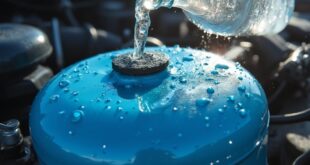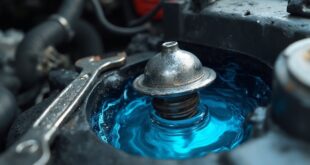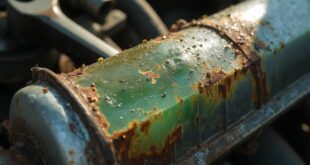Bank 1 and Bank 2 refer to cylinder arrangements in an engine. Bank 1 includes cylinder 1 and other odd-numbered cylinders, while Bank 2 consists of cylinder 2 and even-numbered cylinders. O2 sensors are typically located upstream (Sensor 1) and downstream (Sensor 2) of the catalytic converter. Understanding these designations is essential for accurate sensor location and engine diagnostics. More details on their significance and function will further clarify this topic.
Definition of Bank 1 vs. Bank 2
The distinction between Bank 1 and Bank 2 in an engine is crucial for understanding its configuration.
Bank 1 refers to the side of the engine that houses cylinder 1, encompassing cylinders 1, 3, 5, and 7. Conversely, Bank 2 contains cylinder 2, comprising cylinders 2, 4, 6, and 8.
Engine orientation plays a critical role in bank location, particularly in transverse engines, where Bank 1 often sits at the front.
Accurate cylinder identification can be found in the vehicle's repair manual or on engine stamps, as global driving positions can mislead assumptions regarding driver or passenger side identification.
Understanding Sensor 1 & Sensor 2
While examining the exhaust system, it becomes essential to differentiate between Sensor 1 and Sensor 2, as their placement considerably impacts vehicle diagnostics. Sensor 1 is situated upstream, closest to the engine, while Sensor 2 is located downstream, after the catalytic converter. This distinction plays a vital role in monitoring exhaust emissions and facilitating efficient engine performance.
| Sensor Type | Location |
|---|---|
| Sensor 1 | Upstream (Before Catalytic Converter) |
| Sensor 2 | Downstream (After Catalytic Converter) |
Similarity of Bank Sensors
Many vehicles feature O2 sensors on both Bank 1 and Bank 2 that are designed to perform similar functions.
Typically, these sensors monitor exhaust gases to guarantee peak engine performance and emissions control.
While they are generally identical in design and operation, variability can exist depending on the specific car model and sensor type.
It is advisable for vehicle owners to consult repair manuals or contact dealerships for precise sensor identification.
Despite potential differences arising from engine design or manufacturer specifications, the fundamental role of these sensors across both banks remains consistent in most cases.
Bank Position Clarification
Understanding the placement of engine banks is essential for accurate diagnostics and repairs. Bank 1 does not necessarily correspond to the driver or passenger side of a vehicle; its location is determined by the engine's configuration and cylinder numbering.
Proper identification relies on recognizing that Bank 1 contains cylinder 1, while Bank 2 contains cylinder 2. Additionally, Bank 2 does not correlate with front or rear positioning.
Instead, sensor designation clarifies their location in the exhaust system, with Sensor 1 being upstream and Sensor 2 downstream. Accurate identification prevents costly errors during repairs and maintenance.
Exhaust vs. Intake Side
The distinction between Bank 1 and Bank 2 does not imply a direct relationship to the exhaust or intake sides of an engine. Instead, these designations are based on cylinder arrangement, with Bank 1 including cylinders 1, 3, 5, and 7, while Bank 2 encompasses cylinders 2, 4, 6, and 8.
The engine's design ultimately determines how these banks interact with the intake and exhaust systems. Understanding the basic configuration of the engine simplifies the comprehension of bank designations, reducing confusion about where O2 sensors are located within the broader context of the engine's function and performance.
Frequently Asked Questions
How Do I Find My Vehicle's Cylinder Layout?
To determine a vehicle's cylinder layout, one should consult the repair manual, which typically includes diagrams. Engine stamps may also provide identification, ensuring accurate reference to the specific arrangement of cylinders within the engine.
Can I Use Any O2 Sensor for Replacement?
The individual wondered if any O2 sensor could suffice for replacement. However, compatibility varies by vehicle model and engine type, necessitating specific sensors tailored to each configuration for best performance and functionality. Accuracy is essential.
Does Engine Size Affect Bank Sensor Placement?
The engine size does not directly affect bank sensor placement. Instead, sensor location is determined by engine design and cylinder configuration, making it essential to reference specific engine specifications rather than size alone for accurate placement.
Can O2 Sensors Fail Without Triggering a Warning Light?
O2 sensors can indeed fail without triggering a warning light, as their degradation may not always produce detectable faults. Regular monitoring and diagnostic checks are essential for identifying such issues before they affect engine performance.
What Tools Are Needed to Replace O2 Sensors?
To replace O2 sensors, one typically requires a socket wrench, O2 sensor socket, torque wrench, and possibly a penetrating oil. Safety glasses and gloves are advisable for protection during the replacement process.
 Car Service Land Coupons for Oil change, Tires, Wheel alignment, Brakes, Maintenance
Car Service Land Coupons for Oil change, Tires, Wheel alignment, Brakes, Maintenance




